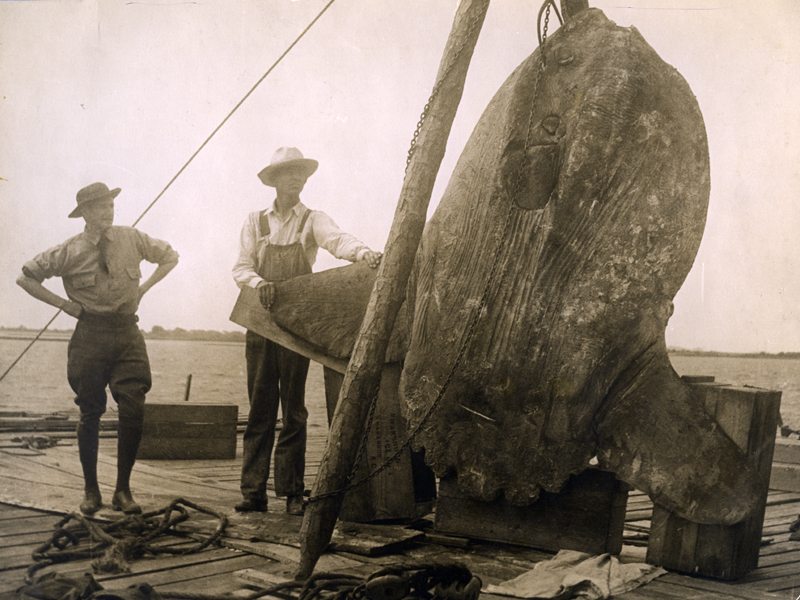On Exhibit: Ocean Sunfish
April 07, 2025

On Monday morning, May 31, 1926, H.H. Brimley, director of what was then known as the North Carolina State Museum, answered his phone. On the other end of the line a faint but very excited voice announced: “Humphrey talking! From Swansboro! Big fish — 1,500 pounds — 7½ feet long — nothing like it ever seen here before.”
Brimley, who had a fascination with the large fauna of North America, responded “Hold that fish! We’ll be right there.” He and his assistant Harry Davis quickly packed up skinning knives, hatchets, a steel tape measure and a change of work clothes. Speed was necessary when dealing with what they thought would be a rapidly decomposing fish, so off they went.
The “big fish” they were going to pick up was an ocean sunfish, or Mola mola. Molas are peculiar fish: large and flat with a ridiculously small mouth for their size. They will drift along the surface of the water lying on their side. They are gentle and curious and generally do not bother humans. This particular fish had gotten stranded on a nearby sand bar and died, but a local captain towed it into Swansboro on his way home from a fishing trip.
Upon arrival at Swansboro, Brimley and Davis were relieved to find the specimen in good condition and packed in ice. Now they had to determine the most economical method for preserving the body. They decided to make a plaster cast of the body and fins and later use papier mâché to create a model. It was too late in the day to begin the project, so they packed another 300 pounds of ice on the fish and returned to a nearby hotel.
They placed an order for 800 pounds of plaster to be delivered the next morning. Then, as Brimley put it, “we turned in to be lulled to sleep by the murmur of the wind, the lapping waves along the shore, and the soft caresses of the salt sea-air — and to dream of herds of monster fish waiting in line for the privilege of becoming Museum specimens.”
But the plaster did not arrive on time and with the ice on the specimen melting fast, they needed a new plan. Instead of making a mold on-site, the two curators decided to save the entire skin from one side of the fish, along with the two fins and the jawbones. They also took many photographs, measurements, notes and made sketches.
Back at the Museum, Brimley, who was an expert taxidermist, sketched the fish to scale. It was 8 feet vertically from fin tip to fin tip and 7 feet in length. The oval mouth was only 3 x 5½ inches. Brimley made a framework of white pine and cypress, then fashioned ¼- inch galvanized wire netting around the framework, then covered it in papier mâché.
Next, using the saved skin as a reference, Brimley and Davis painted and repainted the 150-pound model at least six times before they were satisfied. “Sunny” has remained on exhibit from that day on.
Visitors can see Sunny in the Nature’s Explorers Hall (NEC 2nd floor).
For more information about our upcoming activities, conservation news and groundbreaking research, follow @NaturalSciences on Instagram and Facebook.

